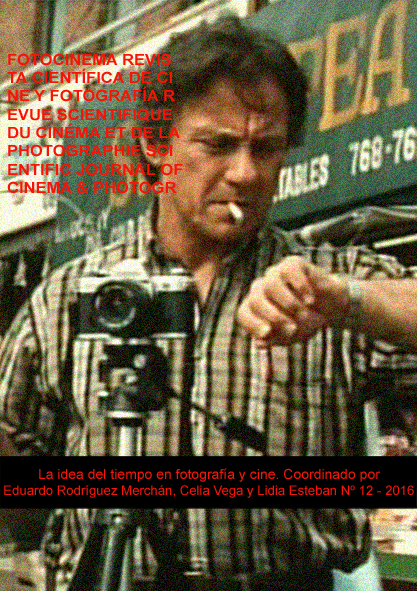La revuelta temporal como método de la vanguardia de entreguerras
DOI:
https://doi.org/10.24310/Fotocinema.2016.v0i12.6040Abstract
El cine de vanguardia es un medio privilegiado para estudiar la experiencia temporal moderna porque es un complejo compendio de tiempos y discontinuidades. Y a su vez, la temporalidad es clave para definir y estudiar la vanguardia cinematográfica. En ella se unen el interés por la exploración del movimiento, los experimentos con la imagen, la desafección narrativa y la afección por lo real. Propone también la subversión del campo fílmico (y, por veces, social). Los cineastas de vanguardia no construían un discurso temporal alternativo pero sí se dotaban de un cuerpo coherente de revuelta basado en la exploración de esas temporalidades diversas. Trataron también de establecer la imagen como método, de deconstruir la racionalización instrumental del dominio visual y propusieron que de la variedad de discursos temporales en convivencia emanaba una nueva forma de historia y de imagen. Este artículo es un ensayo sobre el método de análisis de la temporalidad en la vanguardia.
Abstract:
Avant-garde cinema is a privileged means to study the modern time experience because it is a complex compendium of times and discontinuities. At the same time, the temporality is a key element to define and study the 20’s cinematographic avant-garde. This cinema is characterized by the exploration of movement, the experiments with the image, its lack of interest in narrativity and its interest on the real. It also proposes a subversion of the filmic field (and sometimes, also the social field).Avant-garde filmmakers did not construct an alternative temporal discourse but they organized a coherent uprising corpus based on the exploration of those diverse temporalities. They established the image as a method, the deconstruction of the instrumental rationalization of the visual dominion and they proposed that a new type of history and image emanates from the coexistence of the variety of temporal discourses.
This paper is an essay on methods to study avant-garde temporality.
Palabras clave:
Cine de vanguardia; temporalidad; años 20; entreguerras; Benjamin.
Keywords:
Avant-garde Cinema; Time; 20’s; Interwar Period; BenjaminDownloads
Metrics
Downloads
Published
How to Cite
Issue
Section
License
All contents published in Fotocinema Revista científica de cine y fotografía are protected under the Creative Commons Attribution-NonCommercial-ShareAlike 4.0 International (CC BY-NC-SA 4.0) license. All about this license is available in the following link: <http://creativecommons.org/licenses/by-nc-sa/4.0>
Users can copy, use, redistribute, share and exhibit publicly as long as:
- The original source and authorship of the material are cited (Journal, Publisher and URL of the work).
- It is not used for comercial purposes.
- The existence of the license and its especifications are mentioned.
There are two sets of authors’ rights: moral and property rights. Moral rights are perpetual prerogatives, unrenounceable, not-transferable, unalienable, imprescriptible and inembargable. According to authors’ rights legislation, Fotocinema. Revista científica de cine y fotografía recognizes and respects authors moral rights, as well as the ownership of property rights, which will be transferred to University of Malaga in open access. The property rights are referred to the benefits that are gained by the use or the dissemination of works. Fotocinema. Revista científica de cine y fotografía is published in an open access form and it is exclusively licenced by any means for doing or authorising distribution, dissemination, reproduction, , adaptation, translation or arrangement of works.
Authors are responsable for obtaining the necessary permission to use copyrighted images.













13.png)




